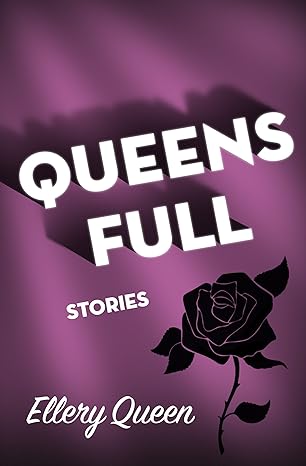Ellery Queen was visiting Bethesda University when physicist Dr. Herbert Agon failed to make his nightly phone call with the President about a top secret and was found stabbed in the back with a stiletto. A cryptic drawing is found bawled in his left hand and is the only clue to the killer’s identity. A friend of Queen’s, General Carter, tell the Chancellor to bring Queen on this top secret case, find Dr. Agon’s stolen notes, and bring the killer to justice
The Review
Ellery Queen was visiting Bethesda University when physicist Dr. Herbert Agon failed to make his nightly phone call with the President about a top secret and was found stabbed in the back with a stiletto. A cryptic drawing is found bawled in his left hand and is the only clue to the killer’s identity. A friend of Queen’s, General Carter, tells the Chancellor to bring Queen on this top secret case, find Dr. Agon’s stolen notes, and get the killer to justice.
This micro short story is pure cheesy 1960s science fiction, complete with spycraft, secret formulas, the threat of human extinction, a locked-room mystery, an affair, and a cryptic drawing made by Dr. Agon seconds before his death.
There’s a lot packed into a few short pages, and there could be more meat on the bones. The characters are the broadest stereotypes, and their motivations are incredibly one-note—but they aren’t the story’s focus—it’s all about the mysterious pictogram and the impossible mystery inside a locked room without any record, all before the possible END OF THE WORLD!
This story would be right at home inside the pages of Ellery Queen Magazine. It’s a clever little puzzle that gives you a quick jolt of happiness. It’s like a piece of candy in the middle of the day: sweet, enjoyable, and without any sustenance.
I liked the very 60s teleplay approach to telling the story, with all of the professors being over-the-top eggheads, the wives being vamps, and the security guard straight out of a Jetson cartoon—more brawn than brains and easier to trick than a Labrador.
The teleplay approach does lend itself to rushing from scene to scene with little connective tissue. There’s no time to add layers, motivations, or color to the scenery; this is a few pages focused on who stabbed Dr. Argon and how.
I would have liked my story to be a little more fat in terms of characterization, especially Ellery Queen, who is going from place to place like his pants are on fire. He’s niggling just under frantic, and I would have preferred a cooler, more collected, and intentional Ellery Queen, who runs counter to the elevated emotions of the other character.
The only real nuance in the story is around solving the pictogram, and it’s not too hard to solve. The explanation is far-fetched but leans into the story’s overall campiness and heightened gravitas.
If you like campy science fiction and locked-room mysteries that don’t require 300 pages and a Ph.D. to solve (I’m looking at you, John Dickson Carr), this will hit the spot.
Ellery Queen Detective Series Reviews

Ellery Queen Detective # 9: The Spanish Cape Mystery (1935)

Ellery Queen Biography
Ellery Queen is the pseudonym used by cousins Frederic Dannay and Manfred Lee, who were American cousins and prominent authors of detective fiction. Their main character, Ellery Queen, is also the protagonist of the majority of their works. The duo adopted the pseudonym in order to create a distinctive identity for their mystery novels and to maintain the mystery surrounding the authorship of their works.
Frederic Dannay, born Daniel Nathan, and Manfred Lee, born Manford Lepofsky, were both born in Brooklyn, New York. They began their collaboration in the late 1920s, writing and editing together. Their first novel featuring Ellery Queen, “The Roman Hat Mystery,” was published in 1929 and introduced the character of Ellery Queen, an amateur detective and mystery writer.
The Ellery Queen novels often followed a similar pattern, with intricate plots, clever puzzles, and a focus on deductive reasoning. Ellery Queen himself was portrayed as an intellectual detective, often solving cases through logical analysis and deduction rather than physical strength or action.
The cousins also created a number of other mystery series under the Ellery Queen pseudonym, including novels featuring Inspector Richard Queen, Ellery’s father, and Drury Lane, a retired actor turned amateur sleuth.
In addition to their novels, Dannay and Lee were involved in other aspects of mystery fiction, including editing anthologies and writing critical essays. They also co-founded Ellery Queen’s Mystery Magazine, a popular publication that continues to feature mystery fiction today.
Ellery Queen’s influence on the mystery genre is significant, with their works helping to shape the conventions of detective fiction and inspiring countless other authors and works in the genre. Although both cousins have passed away (Dannay in 1982 and Lee in 1971), their legacy as Ellery Queen continues to be celebrated by mystery fans around the world.





Leave a comment